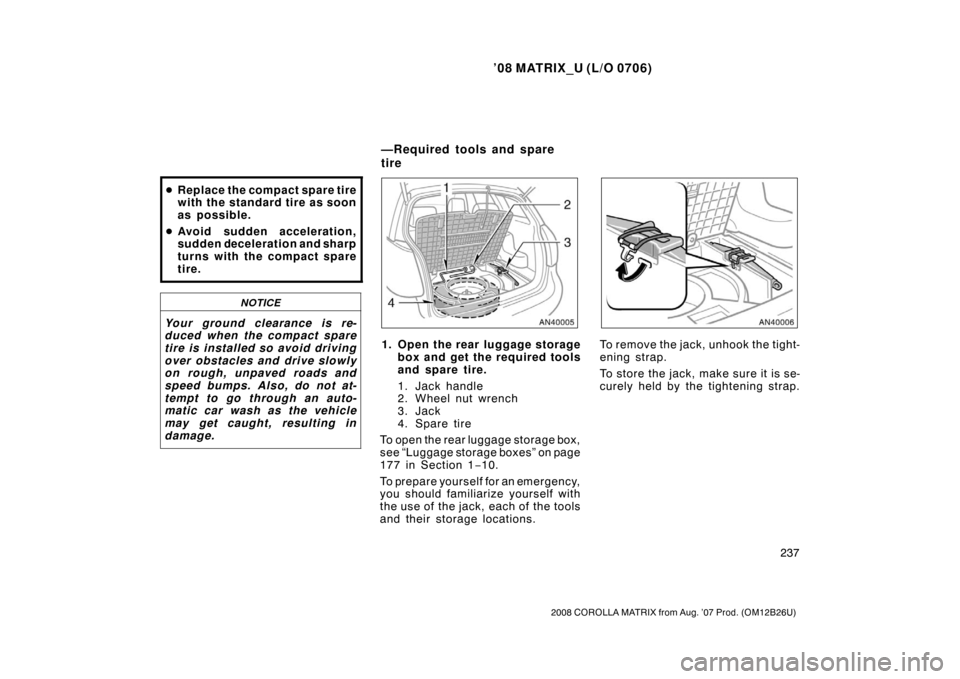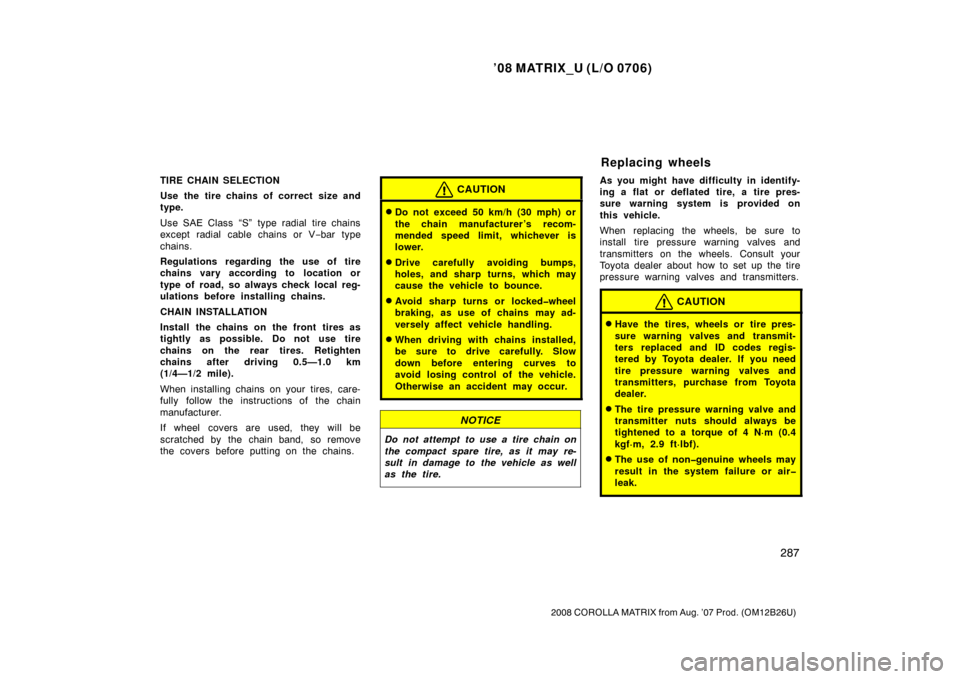Page 209 of 326
’08 MATRIX_U (L/O 0706)
199
2008 COROLLA MATRIX from Aug. ’07 Prod. (OM12B26U)
This illustration indicates typical tire
symbols.1. “TEMPORARY USE ONLY”— A
compact spare tire is identified by
the phrase “TEMPORARY USE
ONLY” molded into its sidewall.
This tire is designed for temporary
emergency use only. For details,
see “Compact spare tire” on page
236.
2. Tire size— F or det ails, see “— Ti re
size” on page 201.
3. DOT and Tire Identification Number (TIN)— For details, see
“—DOT and Tire Identification
Number (TIN)” on page 200.
4. The location of the tread wear indicators— For details, see
“Checking and replacing tires” on
page 283.
5. Load limit at maximum cold tire inflation pressure— For details,
see “Vehicle load limits” on page
210 and “Checking and replacing
tires” on page 283.
—Tire symbols (compact spare tire)
Page 247 of 326

’08 MATRIX_U (L/O 0706)
237
2008 COROLLA MATRIX from Aug. ’07 Prod. (OM12B26U)
�Replace the compact spare tire
with the standard tire as soon
as possible.
� Avoid sudden a cceleration,
sudden d eceleration and sharp
turns with the compact spare
tire.
NOTICE
Your ground clearance is re-
duced when the compact spare
tire is installed so avoid driving
over obstacles and drive slowly
on rough, unpaved roads and
speed bumps. Also, do not at-
tempt to go through an auto-
matic car wash as the vehicle
may get caught, resulting in
damage.
1. Open the rear luggage storage box and get the required tools
and spare tire.
1. Jack handle
2. Wheel nut wrench
3. Jack
4. Spare tire
To open the rear luggage storage box,
see “Luggage storage boxes” on page
177 in Section 1− 10.
To prepare yourself for an emergency,
you should familiarize yourself with
the use of the jack, each of the tools
and their storage locations.To remove the jack, unhook the tight-
ening strap.
To store the jack, make sure it is se-
curely held by the tightening strap.
— R eq u ired to o ls an d sp are
tire
Page 294 of 326

’08 MATRIX_U (L/O 0706)
284
2008 COROLLA MATRIX from Aug. ’07 Prod. (OM12B26U)
The effectiveness of snow tires is
lost if the tread wears down below
4 mm (0.16 in.).
If you have tire damage such as
cuts, splits, cracks deep enough to
expose the fabric, or bulges indi-
cating internal damage, the tire
should be repl aced.
If a tire often goes flat or cannot be
properly repaired due to the size or
location of a cut or other damage, it
should be replaced. If you are not
sure, consult with your Toyota dealer.
If air loss occurs while driving, do not
continue driving. Driving even a short
distance can damage a tire beyond
repair.
An y ti res wh i ch are over 6 years
old must be checked by a qualified
technician even if damage is not
obvious.
Tires deteriorate with age even if they
have never or seldom been used.
This applies also to the spare tire and
tires stored for future use. REPLACING YOUR TIRES
When replacing a tire, use a tire of
the same size and construction,
and the same or greater maximum
load as the originally installed
tires.
Using any other size or type of tire
may seriously affect handling, ride,
speedometer/odometer calibration,
ground clearance, and clearance be-
tween the body and tires or snow
chains.
Check that the maximum load of the
replaced tire is greater than 1/2 of the
Gross Axle Weight Ratings (GAWR)
of either the front axle or the rear
axle, whichever is greater. As for the
maximum load of the tire, see the load
limit at maximum cold tire inflation
pressure mentioned on the sidewall
of the tire, and as for the Gross Axle
Weight Ratings (GAWR), see the Cer-
tification Label.
For details about the sidewall of the
tire and the Certification Label, see
pages 194 and 197.
CAUTION
Observe the following instruc-
tions. Otherwise, an accident
may occur resulting in death or
serious injuries.
�
Do not mix radial, bias belted,
or bias�ply tires on your ve-
hicle, as this may cause dan-
gerous handling characteris-
tics resulting in loss of control.
� Do not use tires other than the
manufacturer’s recommended
size, as this may cause danger-
ous handling characteristics
resulting in loss of control.
Page 297 of 326

’08 MATRIX_U (L/O 0706)
287
2008 COROLLA MATRIX from Aug. ’07 Prod. (OM12B26U)
TIRE CHAIN SELECTION
Use the tire chains of correct size and
type.
Use SAE Class “S” type radial tire chains
except radial cable chains or V−bar type
chains.
Regulations regarding the use of tire
chains vary according to location or
type of road, so always check local reg-
ulations before installing chains.
CHAIN INSTALLATION
Install the chains on the front tires as
tightly as possible. Do not use tire
chains on the rear tires. Retighten
chains after driving 0.5—1.0 km
(1/4—1/2 mile).
When installing chains on your tires, care-
fully follow the instructions of the chain
manufacturer.
If wheel covers are used, they will be
scratched by the chain band, so remove
the covers before putting on the chains.CAUTION
�Do not exceed 50 km/h (30 mph) or
the chain manufacturer ’s recom-
mended speed limit, whichever is
lower.
�Drive carefully avoiding bumps,
holes, and sharp turns, which may
cause the vehicle to bounce.
�Avoid sharp turns or locked�wheel
braking, as use of chains may ad-
versely affect vehicle handling.
�When driving with chains installed,
be sure to drive carefully. Slow
down before entering curves to
avoid losing control of the vehicle.
Otherwise an accident may occur.
NOTICE
Do not attempt to use a tire chain on
the compact spare tire, as it may re-
sult in damage to the vehicle as well
as the tire.
As you might have difficulty in identify-
ing a flat or deflated tire, a tire pres-
sure warning system is provided on
this vehicle.
When replacing the wheels, be sure to
install tire pressure warning valves and
transmitters on the wheels. Consult your
Toyota dealer about how to set up the tire
pressure warning valves and transmitters.
CAUTION
�Have the tires, wheels or tire pres-
sure warning valves and transmit-
ters replaced and ID codes regis-
tered by Toyota dealer. If you need
tire pressure warning valves and
transmitters, purchase from Toyota
dealer.
�The tire pressure warning valve and
transmitter nuts should always be
tightened to a torque of 4 N·m (0.4
kgf·m, 2.9 ft·lbf).
�The use of non�genuine wheels may
result in the system failure or air�
leak.
Replacing wheels